Overview
Under the Flammable Fabrics Act (FFA), two standards address the flammability of children’s sleepwear. The Standards for the Flammability of Children’s Sleepwear, codified at 16 C.F.R. parts 1615 and 1616 (Standards), were developed to protect children under the age of 15 years from death and serious burn injury from the ignition of sleepwear by small open-flame ignition sources. At the time the Standards were developed, the children’s clothing fires most frequently involved nightgowns, robes, and traditional pajamas ignited by matches and cigarette lighters. Most of the ignition incidents occurred while children were awake and wearing sleepwear or sleep-related items during the evening before bedtime or in the morning around breakfast time.
The Standards require that all children’s sleepwear must meet the flammability requirements or be “tight-fitting” sleepwear, as defined by specified dimensions. Children’s sleepwear that is not tight-fitting must be flame resistant; the fabric, prototype seam(s), trim(s), and garments must be tested and meet the specified flammability requirements in accordance with the Standards.
Topics of Concern
CPSC staff has become aware of cases in which the fabric and seam and trim prototypes pass the flammability testing requirements, but the production garments fail the testing requirements. Further discussion follows in the Supplemental Data Analysis section.
CPSC staff is also aware of children’s pajamas being tested incorrectly to The Standard for the Flammability of Clothing Textiles, 16 C.F.R Part 1610, instead of the children’s sleepwear Standards. Refer to the following section on Children’s Sleepwear for more details on the scope of the Standards.
Sleepwear garments that fail to meet the requirements of the federal flammability standards are dangerously flammable and are prohibited from entering commerce in the United States.
Children’s Sleepwear
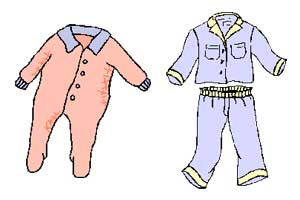
Children’s sleepwear is any article of clothing, such as nightgowns, pajamas, robes, and loungewear garments, sized above 9 months and up to size 14, intended to be worn primarily for sleeping or activities related to sleeping. Nightgowns, robes, and traditional-style loose fitting pajamas must be tested to the flammability requirements for children’s sleepwear.
To determine whether a garment is children’s sleepwear, Commission staff considers several factors, which include: the nature of the garment and its suitability for sleeping or activities related to sleeping; design features of the fabric and garment; how the garment is promoted and distributed; and the likelihood that the garment will be purchased for and used by children primarily for sleeping or activities related to sleeping in a substantial number of cases.
There are a few items that are not subject to the children’s sleepwear standards. For example, a garment sized 9 months or smaller that is intended for use by infants is not required to meet the standard, if it is a one-piece garment and is not longer than 25.75 inches (64.8 cm); or it is a two-piece garment and has no piece longer than 15.75 inches (40.0 cm), and it has a label stating in months the age of the children for whom the garment is intended. Underwear and diapers are not children’s sleepwear.
The exceptions must meet the flammability requirements for clothing textiles, 16 C.F.R. 1610, or vinyl plastic film, 16 C.F.R. 1611. All tight-fitting sleepwear must also meet 16 C.F.R. Parts 1610 and 1611. A “tight-fitting garment” is defined by §1615.1(o) and §1616.2(m) as a garment that does not exceed the maximum allowable dimensions for seven specified locations for each size garment.
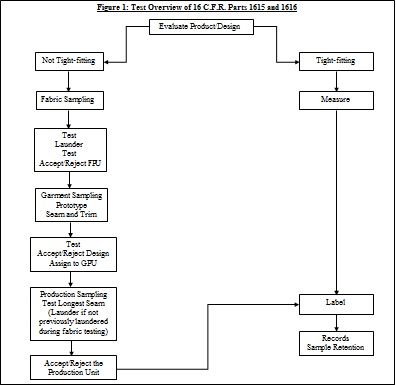
Test Overview
An overview of the Standards is illustrated in Figure 1. The test specifies that a gas flame is applied to the bottom edge of the specimen for three seconds. The char length of each specimen is measured and recorded.
Testing for flammability involves selecting and testing a specified number of samples of three different items – fabric, prototype seams and trim, and production garment seams. Fabric (or garments) must be tested as produced (or after one laundering) and after 50 launderings.
Depending on the results of testing, an item may be accepted, rejected, or require additional sampling and testing. In general, a sample of five specimens cannot have an average char length greater than 7.0 inches or have more than a specified number of individual 10 inch char lengths.
Summary of Sampling and Testing Requirements
Because of the detail in the regulations, only a general overview of the sampling and testing requirements is provided in this bulletin. For more detailed information about the test equipment and procedures, sampling of fabric or garments, selecting specimens, and other requirements, please refer to the regulations, or contact Carolyn Carlin in the Office of Compliance and Field Operations at: 301-504-7889 or ccarlin@cpsc.gov.
Supplemental guidance to the regulations is available in the laboratory test manual for 16 C.F.R. Parts 1615 and 1616 developed by CPSC staff. The manual is available on CPSC’s website.
Fabric (FPU)
Finished fabric that is ready to be made into sleepwear must be grouped into Fabric Production Units (FPUs) and tested before the manufacturer uses the fabric to make prototype garments. An FPU may be up to 5,000 linear yards (4,600 linear meters) of the fabric. The manufacturer may include different colors or print patterns of the same fabric in the same FPU if they exhibit similar burn characteristics. Test one sample of five specimens from each end of each FPU (two samples per FPU) in both the original state (or after a single laundering cycle) and after 50 laundering cycles.
An FPU can be made up of fabrics of different colors or different print patterns in the same colorways on the same fabric but not both different colors and different prints. To include different colors or different print patterns (or the same pattern in different colorways) on the same fabric, three samples from each color or print must be tested and shown to have equivalent flammability performance.
To meet the performance requirements of the Standards, the average char length of the sample must not exceed 7.0 inches (17.8 cm), and no individual specimen may have a char length of 10.0 inches (25.4 cm). The FPU is accepted or rejected based upon the fabric sampling plan criteria. If 15 consecutive FPUs of a fabric are accepted using normal sampling, the number of linear yards of fabric in the FPU may be increased (reduced sampling). In reduced sampling, the sampling plan is the same, however. If an FPU is rejected during normal sampling, subsequent FPUs must be tested with a third sample of five specimens taken from the middle of the FPU.
Testing Requirements Summary
The general test uses a specified number of sample sets of five specimens each, depending on the sampling requirements. Each specimen is to be 3.5 inches (8.9 cm) x 10.0 inches (25.4 cm) and is to be cut from the fabric, garment seams, trims, or garments being tested. The specimens are tested separately after conditioning; each one is placed in a metal holder that is suspended vertically in the test cabinet.
We suggest using good fabric sampling practices be when preparing specimens for testing. For example, specimens should not share warp and filling yarns, when possible. Additionally, specimens should not be located too close to the fabric selvage and should originate from different areas of the fabric (or garment) sampled.
Depending on the results of testing, an item may be accepted, rejected, or require additional sampling and testing. In general, a sample of five specimens cannot have an average char length greater than 7.0 inches (17.8 cm) or have more than a specified number of individual 10.0 inch (25.4 cm) char lengths. Refer to the Standards for specific details regarding sampling and testing.
Garment Seam/Trim Prototypes
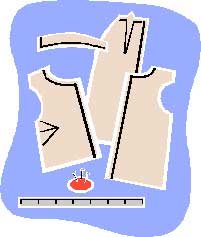
Before the manufacturer produces garments that will be sold, prototypes of each garment design characteristic must be tested. This testing helps to ensure that the manufacturer has designed a garment that will comply with the Standards when the garment is in production. Seam types and trims that will actually be used in the garments must be tested. Most sleeve and neckline bindings/rib cuffs do not have to be tested. Test three samples, five specimens each: of the longest seam type; of each different seam type 10.0 inches or longer; and of each type of trim.
Prototype seams and trims are accepted or rejected based upon the seams/trims prototype sampling plan criteria. Please see the regulations for additional guidance.
Production Garments (GPU)
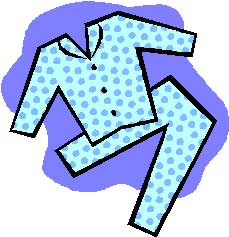
Finished garments produced for sale must be grouped into Garment Production Units (GPUs) and tested. One GPU may include up to 500 dozen garments. A GPU may include garments with different trim and fasteners, as long as the other characteristics of the garments (e.g., fabric, thread, and seam construction) remain unchanged, except for size, color, and print pattern. Therefore, solid colors and print patterns must not be combined in the same GPU, unless testing has been done to demonstrate there is no difference in flammability performance.
From randomly selected garments, test three samples, five specimens each, from the longest type of seam. GPUs are accepted or rejected based upon the production garment (GPU) sampling plan.
Recordkeeping, Specimen Retention Requirements, and Certification
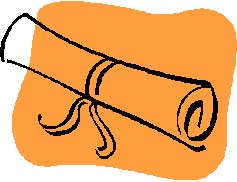
Manufacturers, importers, or other persons initially introducing a children’s sleepwear product into commerce that is subject to the Standards must maintain records and physical samples. The records should provide documentation that establishes a line of continuity from the start of the manufacturing process to the delivery and sale of the finished product. Recordkeeping and sample retention requirements for each FPU and GPU are specified in §§ 1615.31 and 1616.31.
Some of the information that must be maintained includes sampling plan details, fabric (FPU) and/or garment (GPU) production unit identification information, all test results and details (e.g., length of each specimen, char length of each specimen tested, average char length of each sample tested, details of the sampling plan(s) used, name and signature of person(s) conducting the tests, and date of tests performed), disposition details, product specifications, and physical samples.
All required physical and written records needed to document compliance with the test procedures and sampling plans are specified in the Standards.
Records are to be retained for as long as the garment is in production and the tests are relied upon to show compliance plus an additional 3 years.
Supplement Data Analysis Continued
CPSC staff has become aware of cases in which the fabric (FPU) and seam and trim prototypes pass the flammability testing requirements but the production garments (GPU) fail the testing requirements. This outcome can be caused by high variability in the char measurements or a high mean char measurement (or a combination of both) during the seam prototype testing. When this occurs, CPSC staff suggests additional examination of the seam prototype test data to ensure reliable results during the GPU testing. The following suggested supplemental data analysis is based on good lab practice and is for informational purposes only and not required by the regulation.
Because of the inherent variability of fabric flammability performance and the variability that may be introduced during production, CPSC staff recommends that test laboratories pay close attention to individual char measurements that are close to 7.0 inches and/or mean char measurements that are high and close to a 7.0 inch average. The additional analysis of data is particularly important when the overall results are passing.
For example, the data suggest that if the char measurements are inconsistent and have a high variance, but the mean char measurement is 4.0 inches (passing results), more failures are likely to occur during production testing (GPU), than if the char measurements are all close to 4 inches and have a low variance, while the mean char measurement is 4.0 inches. In addition, prototypes that pass with a mean char measurement that is close to 7.0 inches are more likely to have failures in production testing (GPU) than prototypes with a mean char measure that is well below 7.0 inches. Specimens that have char lengths near 7.0 inches are likely to also have char lengths that would exceed 7.0 inches if additional tests were conducted.
A seam prototype that passes but has a mean char measurement near 7.0 inches or with very inconsistent char measurements from sample to sample, is more likely to result in production garments that have failing production (GPU) tests. Seam prototypes that result in tests having a low mean char length (well below 7.0 inches) and low variability (consistent char length measures) are the signs of a seam prototype that is unlikely to result in garments that fail production testing (GPU). Additional sampling is one method to increase the certainty of the prototype test results and ensure reliability of passing results from GPU tests.
There are several possible causes for the variation in flammability behavior and resulting failures that occur during the production testing (GPU). One possible cause is the introduction of other substances, such as oils, residues, or finishes, during sewing or other stages of production. Another reason could be due to the introduction of fuzz or fiber waste generated by friction during cutting, sewing, or other production processes. Thread used to construct the garment seams significantly contributes to the flammability performance of the seam prototypes and garments. Any change in thread, including thread fiber content, thread construction, and twist could cause a change in flammability performance. Finally, changes in flammability behavior may be caused by changes in sewing, thread tension, and stitch length (e.g., stitches per inch).
Sleepwear that Fails the Flammability Tests
Rejected units may not be retested, used, or promoted for use in children’s sleepwear. Rejected units can be destroyed, exported (only with CPSC approval), or reworked to improve their flammability resistance.
The manufacturer must retest reworked units according to the FPU and GPU testing procedure. Such units must comply with the flammability requirements before the fabric or garments are introduced into commerce as children’s sleepwear.
It is a violation of federal law to manufacture for sale, sell, offer for sale, import, and/or distribute garments that are subject to and do not meet the Standards.
This communication has been prepared for general informational purposes only and is based upon the facts and information presented. This communication does not, and is not intended to, constitute legal advice and has not been reviewed or approved by the Commission, and does not necessarily represent its views. Any views expressed in this communication may be changed or superseded by the Commission.

